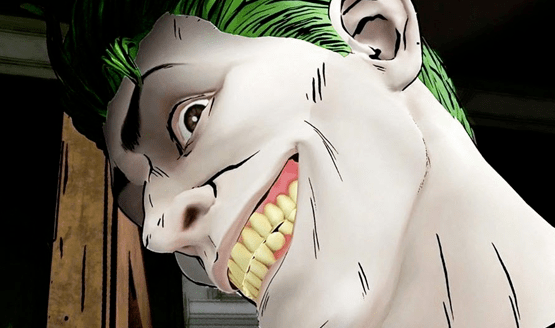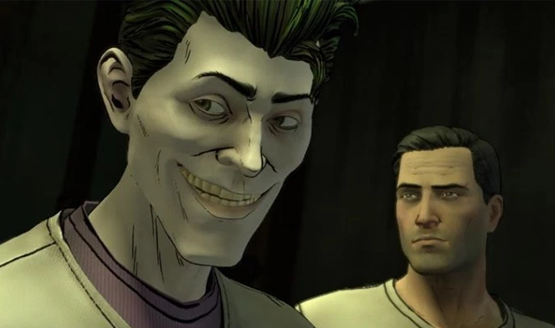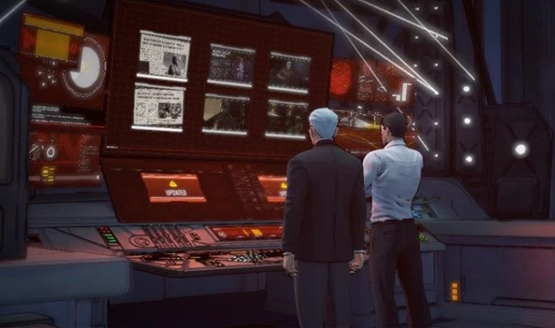This review will contain spoilers for all previous episodes and the current episode of Batman The Telltale Series. Here are our previous reviews for episode 1, episode 2, and episode 3.
I’ve been pretty hard on Telltale’s Batman so far. It’s been exceedingly slow moving and outside of some small points meant to draw gasps from the player, has lacked a real sense of a unique Batman story that necessitates this alternate telling of the World’s Greatest Detective. The familiar building blocks have been paving the way towards episode four where things finally start to get a little interesting. Bruce is locked up in Arkham — Harvey having turned on him whether you sought his friendship earlier or not — and the whole of Gotham despises the Wayne name. Meanwhile the Children of Arkham continue to scheme while Batman can do nothing about it. Seems like a pretty dire situation as Bruce’s politics have made it very difficult for Batman to operate effectively.
Let’s talk about that Harvey betrayal. In a game about choice you certainly are forced into a lot of things, even when you try to alter course as you see the effects coming from a mile away. Take for example, one of the early moments gaining control of Bruce, walking down a hallway you cannot deviate side to side in. The game forces him to walk close enough to a cell door, and sure enough, he’s grabbed. I saw it coming, tried to steer Bruce into the center of the hallway, but for all the width of that path, I was forced by Telltale to veer ever closer to that door, even though being grabbed by the Arkham patient was not pertinent and had no bearing on the story.
Ok, I thought to myself, I can get past that. It’s early in the episode and they are just trying to set the mood, show his vulnerability. Then the very next moment was more walking down a hallway. Literally pushing forward was the only thing I could do, like the slowest and most boring quick time event in history. A slow time event? And of course I get slammed into from behind as another patient darts for a phone, because even though I didn’t want to be blocking the hallway, I didn’t have much of a choice. Again, a later scene as Batman utilizes this same extreme limitation, forcing you onto a singular path where pressing forward is the only thing that can be done. I get that some of these things are for the purpose of storytelling, but it’s getting to the point where sometimes it feels less like a game and more like holding a button to play a movie.
Joke’s in the Exposition
Rather than tell the story through exploration and inference, it’s narrated through forced paths and boring exposition, which is a shame because things are finally starting to get interesting. Even the action scenes feel weak and lack impact, though I have a feeling this has to do with Telltale’s engine, a point I’ll touch on a little later. There’s the opportunity for Telltale to give a unique view from the inside of Arkham, but Bruce’s stay ends all too quickly, shuffling him back out into the world so the stage can be set for the season finale. Before he leaves however, he meets a grinning green haired man familiar to anybody who knows anything about Batman.
Perhaps “John Doe,” or the Joker, as most of us know him, will make a reappearance and have a bigger part in the finale. He sure seems to know a lot about what’s going on for being such a bit player in Guardian of Gotham, and there are hints that his machinations run deep despite his long stay in the asylum. Honestly, Telltale’s Joker is thus far one of the most dull iterations of the character, walking around Arkham like he’s the cool kid in school. He serves as little more than exposition and the convenient push that Bruce needs to move the narrative forward outside of Arkham.
Just as contrived as his admittance to the asylum, is Bruce’s exit, occurring regardless of Bruce deciding to ally with the Joker and break the rules or not, but now he has the information that he needs to continue the hunt for Lady Arkham and her drug. As the story becomes finally more interesting, artificiality increases as well, feeling less naturally developed and more forced for the sake of interest and plot progression.
Harvey Dent, for example, should not have the power to immediately commit Bruce to the Asylum after one violent outburst. If he does have such power, how did Bruce get out so easily? Is Dent’s motivation for madness really over his assumptions about Bruce and Selina Kyle? How did Penguin find Batman’s secret tech lab and somehow hack everything? Why doesn’t he connect Bruce Wayne to Batman despite the secret bat tech lab entrance being in Bruce Wayne’s former office? How are Penguin and Dent both able to fight and nearly take down Batman barehanded?
Hard Choices
This is what happens when you make a story with multiple choices and outcomes, yet funnel things into certain choke points that need to occur. You get characters and motivations that don’t make sense. Maybe if I hadn’t been such a friend to Harvey and saved him from becoming Two-Face, his motivations would seem more logical. Perhaps if I hadn’t left Lucius at Wayne Enterprises to safeguard all of Batman’s tech, it would be more believable that Penguin had garnered control over Batman’s technology (though how he managed to connect Wayne Enterprises and Batman is still beyond me). Maybe I didn’t make the choices that Telltale wanted me to make, but hey, doesn’t that kind of defeat the purpose?
The best thing about this episode is the difficulty of the choices, with the end results screen revealing that there was a pretty even division on how everyone approached each big situation in the episode. It also has pretty major differences in the conclusion, with one resulting in the end of Batman’s livelihood, and the other resulting in the destruction of Bruce’s, and one of two villains captured while the other one remains at large. It seems like it will have a pretty significant impact on episode five, and I remain cautiously optimistic going into the finale despite the contrivances, as the stakes have been significantly raised and the pace is moving much faster than the first three episodes.
Engine Trouble
Alright Telltale, we need to talk about your engine, which is beginning to feel like it lacks much impact and emotion for the storytelling. There were a number of instances, most notably towards the end of the episode, where the game stuttered and loaded for extended periods, but it’s not just the performance problems that I take issue with. Character animations feel stiff and deliberately animated. A number of times the mouth movements didn’t match up with the voice lines. Action lacks weight, so the fight scenes feel cheesy and rehearsed, like the characters are blocking a scene for a school play. Too many instances saw a disconnect between the sound and the animations, or even causes and effects, such as reactions to punches and explosions not feeling cohesive with the scene and environment. It doesn’t help that it’s not believable for scrawny little Cobblepot to take on a highly physically trained Batman in his full gear.
For everything that Guardian of Gotham does right, it makes all the wrong moves to get there. The story reaches a precipice of intensity after a very slow burn over the last three episodes, and the dire situations at hand seem impossible to resolve within a single finale, with far too many threads left open after the conclusion of this penultimate episode. I really wish that the story had built to this level of intensity much earlier instead of waiting this long, but it’s great to finally see this Batman tale coming to fruition with real stakes for the dark knight, even if it has to come through forced storytelling and a poor use of the engine.
Batman: The Telltale Game Series Season Pass review code provided by publisher. Reviewed on PS4. For more information on scoring please see our Review Policy.
-
Story is getting interesting
-
Difficult choices to make throughout the episode
-
Major story points are reached through contrivances
-
Artificial looking character animations
-
Action lacks any weight











